Related Research Articles
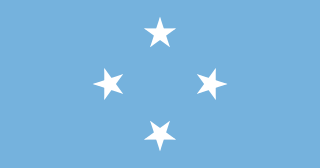
The Federated States of Micronesia, or simply Micronesia, is an island country in Oceania. It consists of four states – from west to east, Yap, Chuuk, Pohnpei and Kosrae – that are spread across the western Pacific. Together, the states comprise around 607 islands that cover a longitudinal distance of almost 2,700 km (1,678 mi) just north of the equator. They lie northeast of Indonesia and Papua New Guinea, south of Guam and the Marianas, west of Nauru and the Marshall Islands, east of Palau and the Philippines, about 2,900 km (1,802 mi) north of eastern Australia, 3,400 km (2,133 mi) southeast of Japan, and some 4,000 km (2,485 mi) southwest of the main islands of the Hawaiian Islands.

The Federated States of Micronesia are located on the Caroline Islands in the western Pacific Ocean. The history of the modern Federated States of Micronesia is one of settlement by Micronesians; colonization by Spain, Germany, and Japan; United Nations trusteeship under United States-administered Trust Territory of the Pacific Islands; and gradual independence beginning with the ratification of a sovereign constitution in 1979.
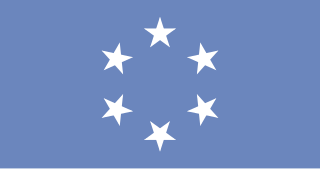
The Trust Territory of the Pacific Islands (TTPI) was a United Nations trust territory in Micronesia administered by the United States from 1947 to 1994.

Pohnpei "upon (pohn) a stone altar (pei)" is an island of the Senyavin Islands which are part of the larger Caroline Islands group. It belongs to Pohnpei State, one of the four states in the Federated States of Micronesia (FSM). Major population centers on Pohnpei include Palikir, the FSM's capital, and Kolonia, the capital of Pohnpei State. Pohnpei Island is the largest (334 km2 [129 sq mi]), with a highest point (782 m [2,566 ft]), most populous, and most developed single island in the FSM.

The Caroline Islands are a widely scattered archipelago of tiny islands in the western Pacific Ocean, to the north of New Guinea. Politically, they are divided between the Federated States of Micronesia in the eastern part of the group, and Palau at the extreme western end. Historically, this area was also called Nuevas Filipinas or New Philippines, because they were part of the Spanish East Indies and were governed from Manila in the Philippines.
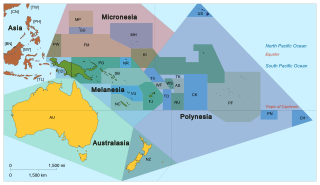
Pacific Islanders, Pacificer, Pasifika, or Pasefika, are the peoples of the Pacific Islands—particularly those who are indigenous to them.
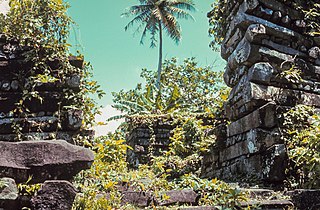
Nan Madol is an archaeological site adjacent to the eastern shore of the island of Pohnpei, now part of the Madolenihmw district of Pohnpei state in the Federated States of Micronesia in the western Pacific Ocean. Nan Madol was the capital of the Saudeleur Dynasty until about 1628. The city, constructed in a lagoon, consists of a series of small artificial islands linked by a network of canals. The site core with its stone walls encloses an area approximately 1.5 km long by 0.5 km wide and it contains nearly 100 artificial islets—stone and coral fill platforms—bordered by tidal canals.

The Senyavin Islands belong to the Federated States of Micronesia. They consist of a larger volcanic Pohnpei Island and two small atolls Ant and Pakin.

The Saudeleur Dynasty was the first organized government uniting the people of Pohnpei island, ruling from around 1100 to around 1628. The era was preceded by the Mwehin Kawa or Mwehin Aramas, and followed by Mwehin Nahnmwarki. The name Deleur was an ancient name for Pohnpei, today a state containing the capital of the Federated States of Micronesia.
Micronesian mythology comprises the traditional belief systems of the people of Micronesia. There is no single belief system in the islands of Micronesia, as each island region has its own mythological beings.
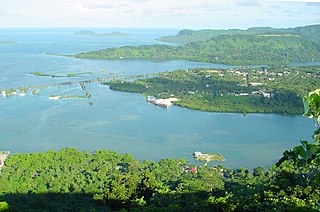
Kolonia is a coastal town and the capital of Pohnpei State in the Federated States of Micronesia (FSM). It was also the former FSM capital before being replaced by Palikir in 1989, located nearby to the southwest in the municipality of Sokehs. It has 6,074 people.
Japanese settlement in what constitutes the present-day Federated States of Micronesia (FSM) dates back to the end of the 19th century, when Japanese traders and explorers settled on the central and eastern Carolines, although earlier contacts can not be completely excluded. After Japan occupied the islands in 1914, Japanese migrated to the Carolines on a large scale in the 1920s and 1930s. The Japanese government encouraged immigration to the islands belonging to the South Seas Mandate in order to offset demographic and economic problems facing Japan at that time.
Japanese settlement in the Marshall Islands was spurred on by Japanese trade in the Pacific region. The first Japanese explorers arrived in the Marshall Islands in the late 19th century, although permanent settlements were not established until the 1920s. As compared to other Micronesian islands in the South Seas Mandate, there were fewer Japanese who settled in the islands. After the Japanese surrender in 1945, the Japanese populace were repatriated to Japan, although people of mixed Japanese–Marshallese heritage remained behind. They form a sizeable minority in the Marshall Islands' populace, and are well represented in the corporate, public and political sectors in the country.
Mori Koben was a Japanese businessman and adventurer, who was best remembered as one of the first Japanese pioneers in Micronesia. As a young man, Mori migrated from Japan to Chuuk, where he helped to establish Japanese businesses in Micronesia. Mori's guidance and direction helped to expand Japanese business interests throughout Micronesia during the Spanish and German colonial-era. After Japan annexed Micronesia from Germany in 1914, Mori was hired as an adviser to the Japanese administration in the South Seas Mandate, and was instrumental in encouraging Japanese settlement in Micronesia. In his final years during World War II, Mori facilitated Micronesian support in the Japanese war efforts, but was already suffering from failing health from old age. He died within a few days after the Japanese surrender, and a sizeable minority of Micronesians with Japanese ancestry from Chuuk trace their ancestry back to Mori.
Adrienne Lois Kaeppler is an American anthropologist, curator of oceanic ethnology at the National Museum of Natural History at the Smithsonian Institution in Washington, DC. She served as the President of the International Council on Traditional Music between 2005 and 2013. Her research focuses on the interrelationships between social structure and the arts, including dance, music, and the visual arts, especially in Tonga and Hawaii. She is considered to be an expert on Tongan dance, and the voyages of the 18th-century explorer James Cook.
Isokelekel, also called Idzikolkol, was a semi-mythical hero warrior from Kosrae who conquered the Saudeleur Dynasty of Pohnpei, an island in the modern Federated States of Micronesia, sometime between the early 16th century and early 17th century. Some Kosraean variants name this hero Nanparatak, with features closer to Ulithian tales of the same archetype. He is considered the father of modern Pohnpei.

The Catholic Belltower is a historic tower at the Catholic Mission in Kolonia, on the island of Pohnpei in the Federated States of Micronesia. The belltower and adjoining masonry apse are all that remain of a church built in 1909 by German Capuchin missionaries, when Ponape and the other Caroline Islands were administered as part of German New Guinea. The rest of the church was destroyed during the fighting of World War II. The tower is 4.8 metres (16 ft) square, rising to a height of 20.7 metres (68 ft), and the shell of the apse is about 10 metres (33 ft) in height. The tower has a foundation of basalt rock and lime mortar, and is constructed out of concrete bricks.

Albert A. Sturges (1819–1887) was an American Protestant missionary and minister. He was among the first group of American missionaries stationed in Micronesia and helped set up the Congregational church on Pohnpei.
Bailey Olter High School, formerly Pohnpei Island Central School (PICS), and Pacific Islands Central School, is a senior high school in Kolonia, Pohnpei Island, Pohnpei State, Federated States of Micronesia. As of 2018 the school, operated by the Pohnpei State Department of Education, has about 1,500 students, making it the state's largest high school. Its service area includes Kolonia, Nett, Sokehs, and U.
Kosrae State Museum is a museum in Tofol in Kosrae State in the Federated States of Micronesia.
References
- ↑ Woodworth, Stephen C. (1980). Navigating the Micronesian Culture Area: A Guide to Source Materials. Historic Preservation Office, Trust Territory Headquarters.
- ↑ Putt, Neal (2001-06-01). "Heritage conservation in the Pacific Islands". Studies in Conservation. 46 (sup1): 61–72. doi:10.1179/sic.2001.46.Supplement-1.61. ISSN 0039-3630. S2CID 218661728.
- ↑ Dark, Philip J.C. (1988). "Museums in Micronesia". Pacific Arts Newsletter (26): 12–20. ISSN 0111-5774. JSTOR 23408934.
- ↑ "News Shorts" (PDF). Nahlikend en Leng. 1 (1). 1994.
- ↑ Society, Kroeber Anthropological (1981). Kroeber Anthropological Society Papers (PDF). Kroeber Anthropological Society.
- ↑ Kiste, Robert; Marshall, Mac (1999-03-01). American Anthropology in Micronesia: An Assessment. University of Hawaii Press. ISBN 978-0-8248-6142-1.
- 1 2 Yamada, Yasuo (1994). "Lidorkini Museum Transfered" (PDF). Nahlikend en Leng. 1 (3).
- ↑ Hezel, Francis X. (2001-05-01). The New Shape of Old Island Cultures: A Half Century of Social Change in Micronesia. University of Hawaii Press. ISBN 978-0-8248-2393-1.
- ↑ "Green Travel Guide to Micronesia - How to Visit Sustainably". ecofriendlytravels.com. Retrieved 2021-07-16.
- ↑ Hunt, Errol (2000). South Pacific. Lonely Planet. ISBN 978-0-86442-717-5.
- ↑ The Rehabilitation of the German Bell Tower. Pohnpei State Division of Historic Preservation & Cultural Affairs. 1999.